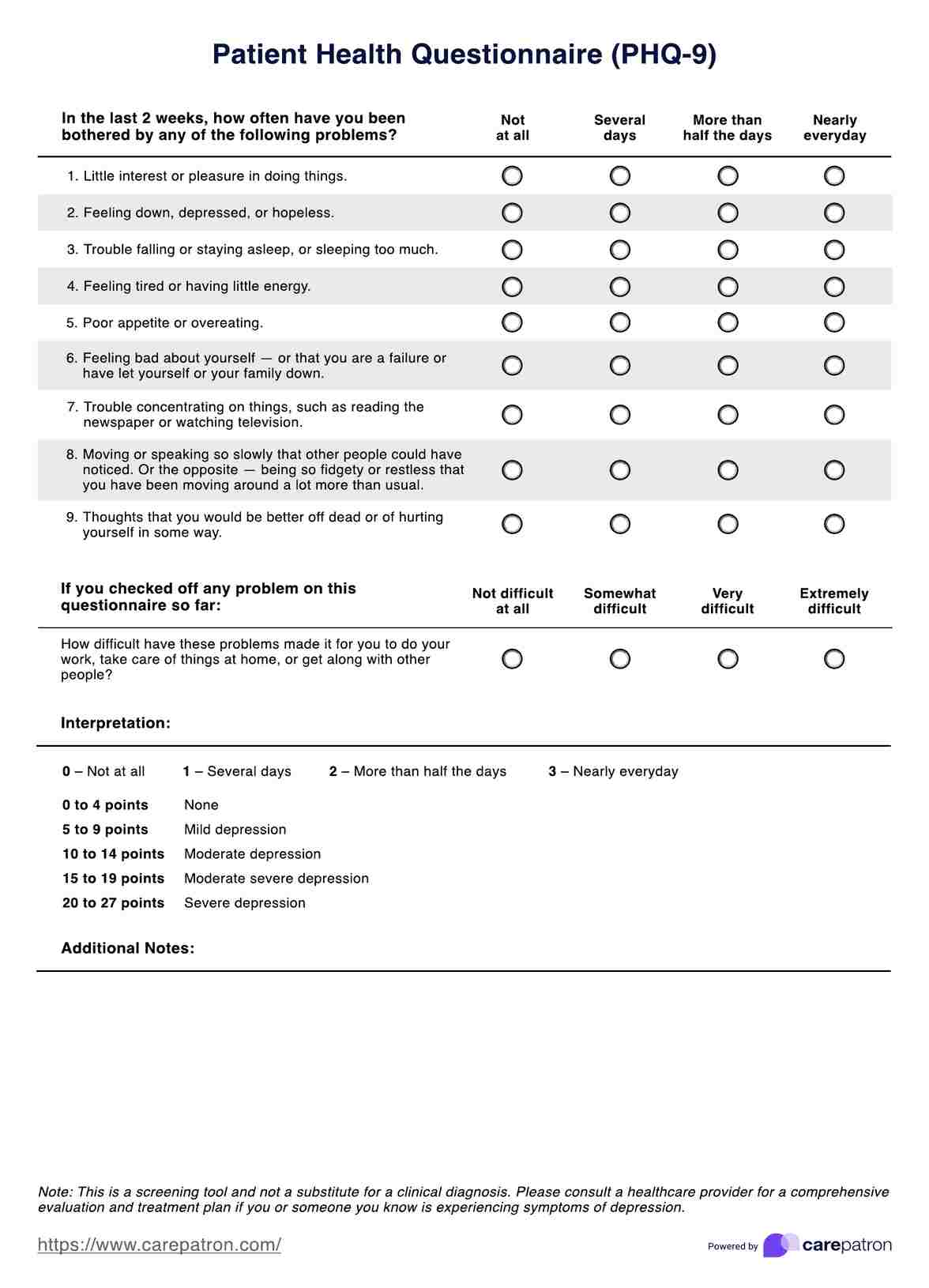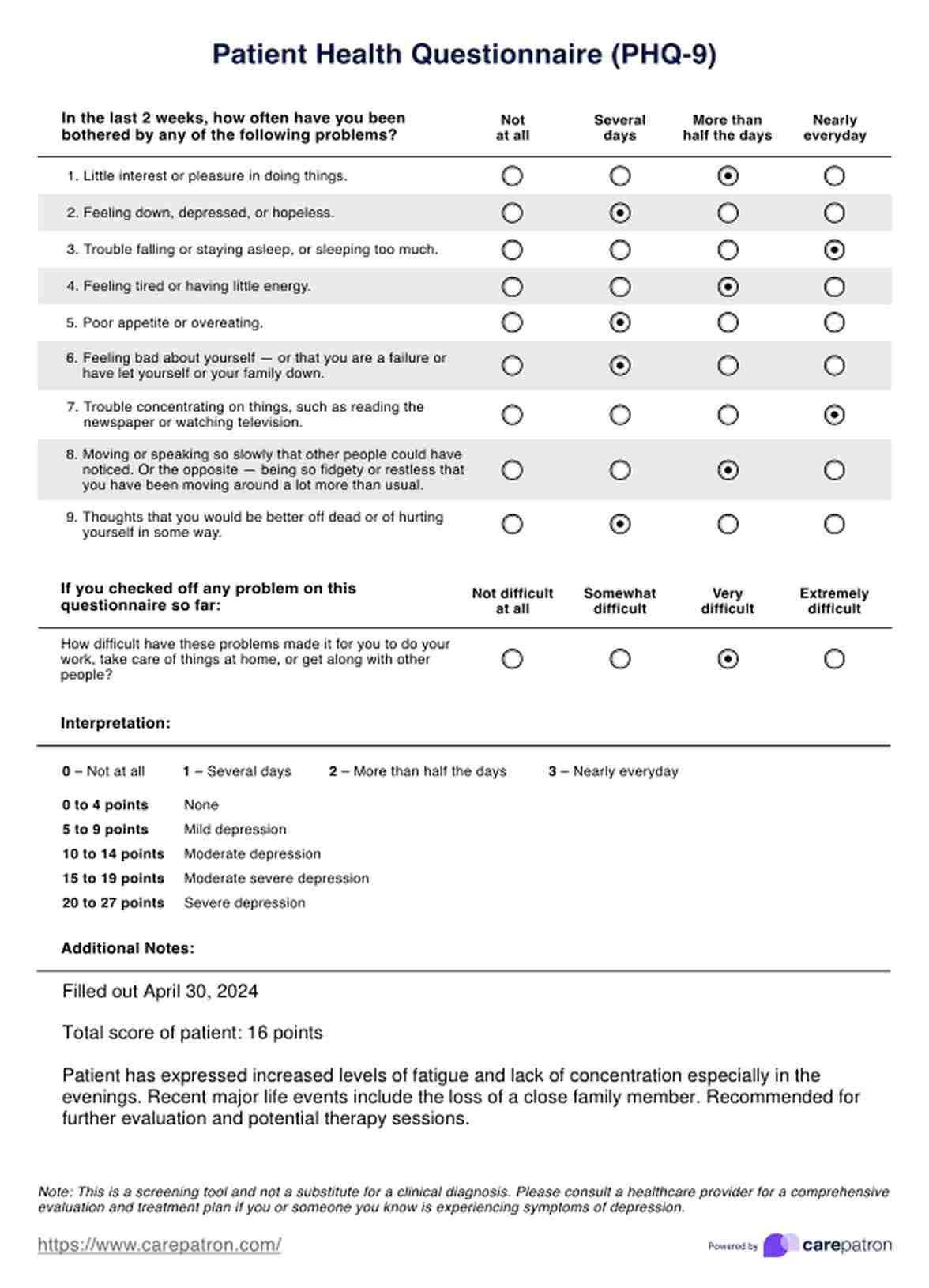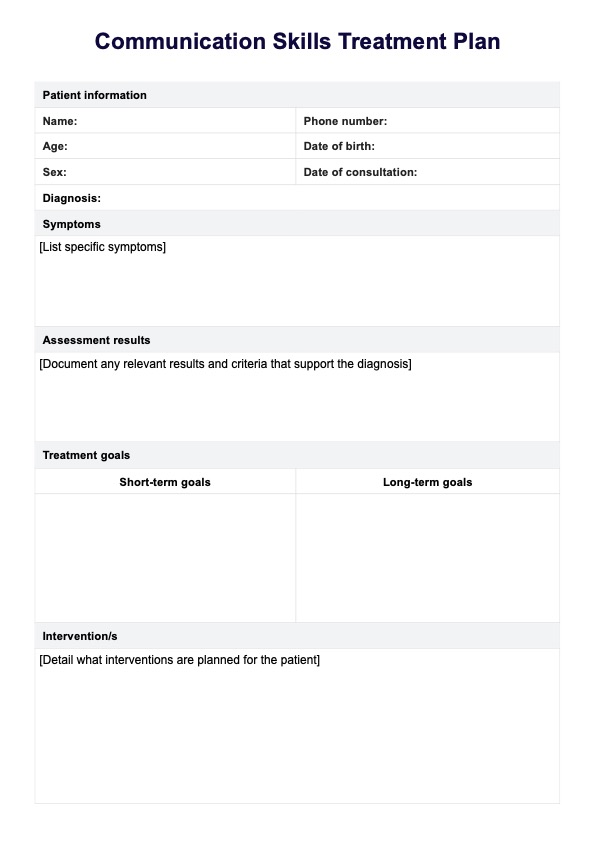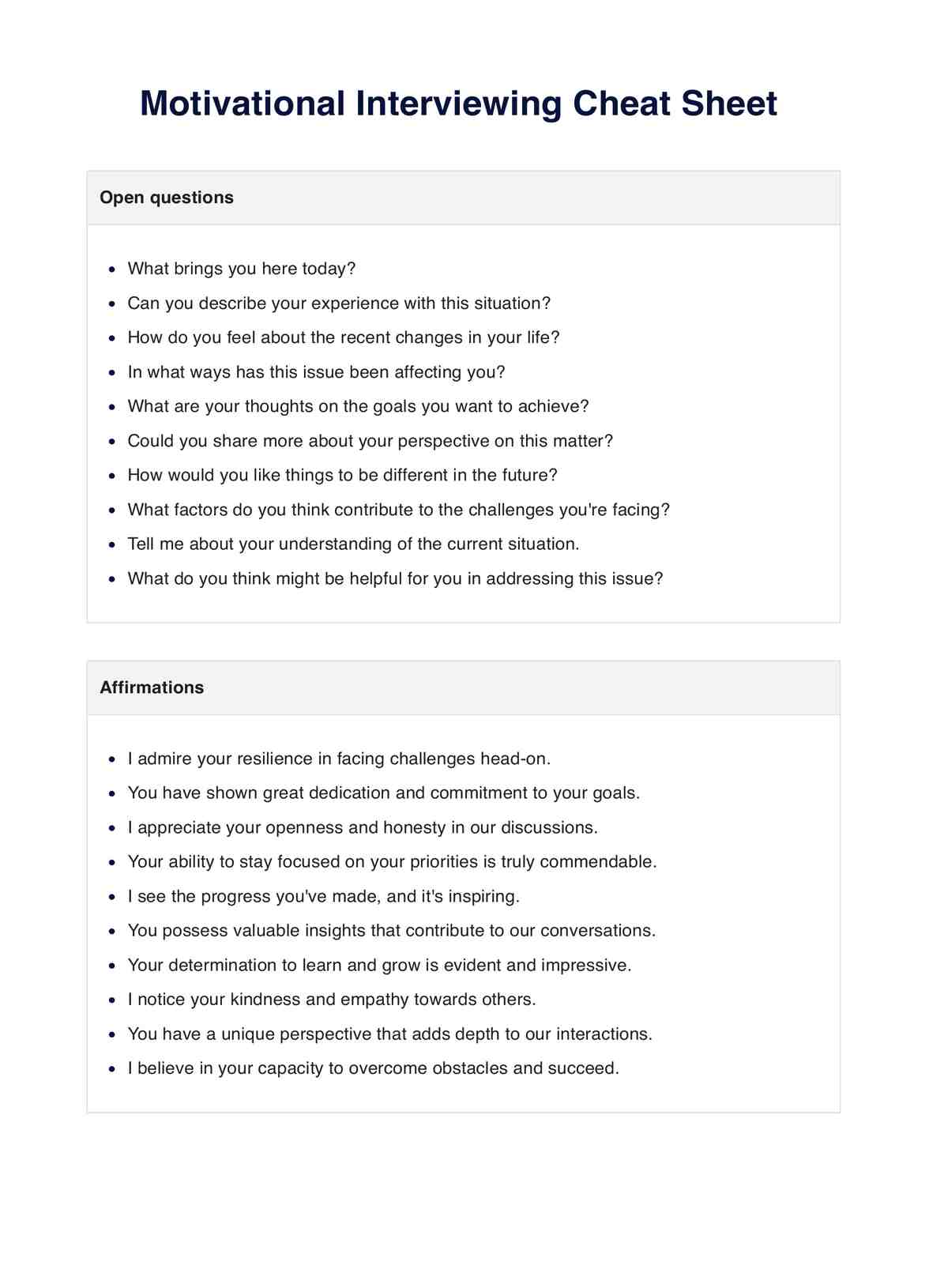Patient Health Questionnaire (PHQ-9)
Discover our free PDF Patient Health Questionnaire (PHQ-9) to closely assess mental health. Take the first step towards managing and evaluating depression symptoms, and alleviate pains to start your journey towards happier and healthier clients.


What is the PHQ-9?
The Patient Health Questionnaire-9 (PHQ-9) is a self-administered diagnostic tool for common mental health conditions, specifically depression. It is a brief depression severity measure that can also be used to monitor response to treatment (Kroenke et al., 2001). Known for its conciseness and high sensitivity, the PHQ-9 prompts individuals to reflect on the frequency of specific symptoms, such as depressed mood experienced over the past two weeks (Kroenke et al., 2010).
Each question in the PHQ-9 corresponds to one of the nine diagnostic criteria for major depressive disorder in the Diagnostic and Statistical Manual of Mental Disorders (DSM). The responses are then scored on a scale from 0 (not at all) to 3 (nearly every day). The total score ranges from 0 to 27, with higher scores indicating more severe depression. The tool provides a quick and efficient way to identify the presence of depression, measure depression symptoms, and facilitate diagnosis.
When should you use the PHQ-9?
The PHQ-9 can be used in various healthcare settings to assess and monitor depression. Here are some common situations where administering the PHQ-9 is recommended:
- Initial screening: The PHQ-9 is an effective tool for screening patients for depression during routine primary care visits, annual check-ups, or when there is a suspicion of depressive symptoms.
- Monitoring treatment response: After initiating treatment for depression, the PHQ-9 can be used to monitor the patient's response to therapy, whether it involves medication, psychotherapy, or a combination of both.
- Follow-up assessments: The PHQ-9 can be administered periodically to track the progression or remission of depressive symptoms over time, allowing healthcare providers to adjust treatment plans as needed.
- Specialized care settings: The PHQ-9 is helpful in various specialized healthcare settings, such as primary care settings, mental health clinics, psychiatric units, and chronic care management programs, where depression is a common comorbidity.
- Research and clinical trials: The PHQ-9 is widely used in research studies and clinical trials related to depression. It provides a standardized measure of symptom severity and treatment outcomes, which can help identify risk factors and those that perpetuate the condition.
It's important to note that while the PHQ-9 is a valuable tool, it should not be used as a sole diagnostic instrument. Healthcare providers should interpret the results with a comprehensive clinical assessment and follow-up evaluations as needed (Manea et al., 2012).
Patient Health Questionnaire (PHQ-9) Template
Patient Health Questionnaire (PHQ-9) Example
How to use the Patient Health Questionnaire (PHQ-9) assessment
Using the Patient Health Questionnaire-9 (PHQ-9) as part of your clinical practice is a strategic approach to detecting, monitoring, and assessing depression severity in patients. The following five steps can help you effectively integrate this depression scale within your practice:
Step 1: Introduce the PHQ-9 to the patient
Explain that the PHQ-9 is a questionnaire used to assess the presence and severity of depressive symptoms. Assure the patient that their responses will be kept confidential and will help provide better care. Emphasize the importance of honest and thorough responses to each item to assess their mental health status accurately.
Step 2: Administer the PHQ-9
Provide the patient with the PHQ-9 questionnaire. It can be administered in various formats — paper-based, digital, or verbal, depending on the patient's comfort level and the resources available in your practice. Instruct them to indicate how often they have been bothered by each problem over the past two weeks, using the provided response options (0 = Not at all, 1 = Several days, 2 = More than half the days, 3 = Nearly every day).
Step 3: Score their responses
Once the patient has completed the questionnaire, calculate the total score by summing up the scores for each of the nine questions. The total score can range from 0 to 27, with higher scores indicating more severe depressive symptoms (Kroenke et al., 2001).
Step 4: Interpret the PHQ-9 score
Interpret the total score in the patient's overall clinical presentation. A higher PHQ-9 score indicates greater severity of depression, which may warrant further clinical assessment, psychoeducation, and discussion about potential treatment options.
Step 5: Develop a treatment plan
Determine the appropriate course of action. This may include initiating or adjusting treatment, referring the patient to a mental health professional, or providing support and resources for self-management.
The PHQ-9 tool should be integrated into a holistic clinical assessment. This can be used alongside other depressive symptom scales or other diagnostic tests. When interpreting the results and planning care, it's vital to consider the patient's broader medical and psychosocial context.
Scoring and interpreting PHQ-9 results
The Patient Health Questionnaire-9 (PHQ-9) is a valuable tool for assessing depression. This nine-item depression scale offers healthcare practitioners a structured and straightforward method for evaluating the severity of depressive symptoms. Here’s a guide on scoring and interpreting the PHQ-9 results effectively.
Scoring the PHQ-9
Every item on the PHQ-9 corresponds to one of the nine DSM-IV criteria for major depressive disorder. Patients rate their experience of each symptom over the past two weeks on a scale of 0 (not at all) to 3 (nearly every day). The total score is the sum of all nine items, ranging from 0 to 27.
- 0-4: None
- 5-9: Mild depression
- 10-14: Moderate depression
- 15-19: Moderately severe depression
- 20-27: Severe depression
Interpreting the results
The total scores provide an indication of the severity of depressive symptoms the patient is experiencing.
- No depression: Scores in this range usually do not indicate a need for clinical intervention unless there are other indicators of functional impairment or distress.
- Mild to moderate depression: These scores suggest the presence of depressive symptoms that may warrant a more detailed clinical interview and further assessment. Patient education and active monitoring are often recommended.
- Moderately severe to severe depression: Scores within these ranges indicate a more significant level of depression. A comprehensive assessment to explore treatment options, including psychotherapy, pharmacotherapy, or a combination of both, is generally advised.
If you need a reference tool to help you administer, score, and interpret PHQ-9, feel free to check out a preview or download this scoring guide.
You can also utilize this patient health questionnaire template to support and enhance your practice and client success.
Who can use these printable Patient Health Questionnaires (PDF)?
Although the PHQ-9 can be self-administered by your patient, the PHQ-9 must be supervised by a trained clinician to interpret the results of this questionnaire correctly. The widespread nature of depressive disorders means many different practitioners may find this questionnaire useful, including:
- Clinical psychologists
- Psychotherapists
- Counselors
- Primary care physicians
- Mental health nurses
- Psychiatrists and psychiatric nurses
Why is this template popular with psychologists?
The PHQ-9's popularity among psychologists stems from its unique combination of efficiency, accuracy, and ease of use. Here's a closer look at the factors that make it such a valuable tool:
- Streamlined screening: The PHQ-9 is concise, with just nine core questions. This allows for quick administration during busy appointments. This translates to more time for in-depth discussions about potential depression and its impact.
- Standardized assessment: The PHQ-9 uses a consistent format and scoring system, ensuring reliable results across settings and healthcare providers. This standardization is crucial for accurate comparisons and tracking progress over time.
- Self-reported data: By allowing patients to complete the PHQ-9 independently, psychologists can access potentially more genuine responses than a direct interview. This can be particularly helpful for individuals who might be hesitant to disclose depressive symptoms verbally.
- Clinician-friendly format: The PHQ-9's straightforward scoring system gives psychologists a clear picture of potential depression severity. This score is a springboard for further evaluation and discussion, guiding treatment decisions.
- Cross-cultural adaptability: The PHQ-9 has been translated into numerous languages and validated across diverse populations and different ethnic groups, making it a valuable tool for culturally sensitive mental health care
References
Kroenke, K., Spitzer, R. L., & Williams, J. B. (2001). The PHQ-9: validity of a brief depression severity measure. Journal of General Internal Medicine, 16(9), 606–613. https://doi.org/10.1046/j.1525-1497.2001.016009606.x
Kroenke, K., Spitzer, R. L., Williams, J. B., & Löwe, B. (2010). The Patient Health Questionnaire Somatic, Anxiety, and Depressive Symptom Scales: A systematic review. General Hospital Psychiatry, 32(4), 345–359. https://doi.org/10.1016/j.genhosppsych.2010.03.006
Manea, L., Gilbody, S., & McMillan, D. (2012). The optimal cut-off score for diagnosing depression with the Patient Health Questionnaire (PHQ-9): a meta-analysis. Canadian Medical Association Journal = Journal de l'Association Medicale Canadienne, 184(3), E191–E196. https://doi.org/10.1503/cmaj.110829
Commonly asked questions
While the PHQ-9 is a valuable screening tool for depression, it is not solely sufficient for a diagnosis. A full clinical assessment, along with other depression scales and other measures, is required to diagnose major depression accurately.
Yes, the PHQ-9 is both reliable and valid. Studies have shown it to be highly reliable and valid for diagnosing depression across different settings and populations. It has relatively sound psychometric properties compared to other depression screening instruments.
It typically takes about 3 to 5 minutes for a patient to complete the PHQ-9, making it a quick and efficient tool for assessing depression severity.




















-template.jpg)

























































































